Life Cycle Characteristics of Warm-Season Severe Thunderstorms in Central United States from 2010 to 2014
Abstract
:1. Introduction
2. Data and Methodology
2.1. Radar Reflectivity Data
2.2. Lightning Data
2.3. Land Cover Data
2.4. Extraction of Thunderstorm Life Cycles
2.5. Directed Graph Representation of Thunderstorms in GIS
3. Results and Discussion
3.1. Temporal Characteristics
3.2. Spatial Characteristics
3.3. Thunderstorm Cell Split and Merger
3.4. Relationship between Thunderstorm Occurrences and Land Cover Types
3.5. Comparison of Thunderstorm Occurrences between Urban and Rural Areas
4. Conclusions
Acknowledgments
Author Contributions
Conflicts of Interest
References
- Han, L.; Fu, S.; Yang, G.; Wang, H.; Zheng, Y.; Lin, Y. A stochastic method for convective storm identification, tracking and nowcasting. Prog. Nat. Sci. 2008, 18, 1557–1563. [Google Scholar] [CrossRef]
- Hocker, J.E.; Basara, J.B. A geographic information systems-based analysis of supercells across Oklahoma from 1994 to 2003. J. Appl. Meteorol. Climatol. 2008, 47, 1518–1538. [Google Scholar] [CrossRef]
- Feidas, H.; Cartalis, C. Application of an automated cloud-tracking algorithm on satellite imagery for tracking and monitoring small mesoscale convective cloud systems. Int. J. Remote Sens. 2005, 26, 1677–1698. [Google Scholar] [CrossRef]
- Hocker, J.E.; Basara, J.B. A 10-year spatial climatology of squall line storms across Oklahoma. Int. J. Climatol. 2008, 28, 765–775. [Google Scholar] [CrossRef]
- Machado, L.A.T.; Rossow, W.B.; Guedes, R.L.; Walker, A.W. Life cycle variations of mesoscale convective systems over the Americas. Mon. Weather. Rev. 1998, 126, 1630–1654. [Google Scholar] [CrossRef]
- Mathon, V.; Laurent, H. Life cycle of Sahelian mesoscale convective cloud systems. Q. J. R. Meteorol. Soc. 2001, 127, 377–406. [Google Scholar] [CrossRef]
- Morel, C.; Senesi, S. A climatology of mesoscale convective systems over Europe using satellite infrared imagery. I: Methodology. Q. J. R. Meteorol. Soc. 2002, 128, 1953–1971. [Google Scholar] [CrossRef]
- Morel, C.; Senesi, S. A climatology of mesoscale convective systems over Europe using satellite infrared imagery. II: Characteristics of European mesoscale convective systems. Q. J. R. Meteorol. Soc. 2002, 128, 1973–1995. [Google Scholar] [CrossRef]
- Lakshmanan, V.; Smith, T. An objective method of evaluating and devising storm-tracking algorithms. Weather Forecast. 2010, 25, 701–709. [Google Scholar] [CrossRef]
- Dixon, M.; Wiener, G. TITAN: Thunderstorm identification, tracking, analysis, and nowcasting-A radar-based methodology. J. Atmos. Ocean. Technol. 1993, 10, 785–797. [Google Scholar] [CrossRef]
- Johnson, J.; MacKeen, P.L.; Witt, A.; Mitchell, E.D.; Stumpf, G.J.; Eilts, M.D.; Thomas, K.W. The storm cell identification and tracking algorithm: An enhanced WSR-88D algorithm. Weather Forecast. 1998, 13, 263–276. [Google Scholar] [CrossRef]
- Meyer, V.K.; Höller, H.; Betz, H.D. Automated thunderstorm tracking: Utilization of three-dimensional lightning and radar data. Atmos. Chem. Phys. 2013, 13, 5137–5150. [Google Scholar] [CrossRef]
- Zahraei, A.; Hsu, K.; Sorooshian, S.; Gourley, J.J.; Hong, Y.; Behrangi, A. Short-term quantitative precipitation forecasting using an object-based approach. J. Hydrol. 2013, 483, 1–15. [Google Scholar] [CrossRef]
- Liu, W.; Li, X.; Rahn, D.A. Storm event representation and analysis based on a directed spatiotemporal graph model. Int. J. Geogr. Inf. Sci. 2016, 30, 948–969. [Google Scholar] [CrossRef]
- Tuttle, J.D.; Foote, G.B. Determination of the boundary layer airflow from a single Doppler radar. J. Atmos. Ocean. Technol. 1990, 7, 218–232. [Google Scholar] [CrossRef]
- Li, L.; Schmid, W.; Joss, J. Nowcasting of motion and growth of precipitation with radar over a complex orography. J. Appl. Meteorol. 1995, 34, 1286–1300. [Google Scholar] [CrossRef]
- Wilson, J.W.; Crook, N.A.; Mueller, C.K.; Sun, J.; Dixon, M. Nowcasting thunderstorms: A status report. Bull. Am. Meteorol. Soc. 1998, 79, 2079–2099. [Google Scholar] [CrossRef]
- Wilson, J.W.; Ebert, E.E.; Saxen, T.R.; Roberts, R.D.; Mueller, C.K.; Sleigh, M.; Pierce, C.E.; Seed, A. Sydney 2000 forecast demonstration project: Convective storm nowcasting. Weather Forecast. 2004, 19, 131–150. [Google Scholar] [CrossRef]
- Changnon, S.A. Climatography of thunder events in the conterminous United States. Part I: Temporal aspects. J. Clim. 1988, 1, 389–398. [Google Scholar] [CrossRef]
- Changnon, S.A. Climatography of thunder events in the conterminous United States. Part II: Spatial aspects. J. Clim. 1988, 1, 399–405. [Google Scholar] [CrossRef]
- Tucker, D.F.; Li, X. Characteristics of warm season precipitating storms in the Arkansas–Red River basin. J. Geophys. Res. 2009, 114. [Google Scholar] [CrossRef]
- Yuan, M. Representing complex geographic phenomena in GIS. Cartogr. Geogr. Inf. Sci. 2001, 28, 83–96. [Google Scholar] [CrossRef]
- McIntosh, J.; Yuan, M. A framework to enhance semantic flexibility for analysis of distributed phenomena. Int. J. Geogr. Inf. Sci. 2005, 19, 999–1018. [Google Scholar] [CrossRef]
- Choi, J.; Olivera, F.; Socolofsky, S.A. Storm identification and tracking algorithm for modeling of rainfall fields using 1-h NEXRAD rainfall data in Texas. J. Hydrol. Eng. 2009, 14, 721–730. [Google Scholar] [CrossRef]
- Han, L.; Fu, S.; Zhao, L.; Zheng, Y.; Wang, H.; Lin, Y. 3D convective storm identification, tracking, and forecasting-An enhanced TITAN algorithm. J. Atmos. Ocean. Technol. 2009, 26, 719–732. [Google Scholar] [CrossRef]
- Chen, M.; Wang, Y.; Gao, F.; Xiao, X. Diurnal variations in convective storm activity over contiguous North China during the warm season based on radar mosaic climatology. J. Geophys. Res. Atmos. 2012. [Google Scholar] [CrossRef]
- Lock, N.A.; Houston, A.L. Spatiotemporal distribution of thunderstorm initiation in the US Great Plains from 2005 to 2007. Int. J. Climatol. 2015, 35, 4047–4056. [Google Scholar] [CrossRef]
- Ashley, W.S.; Bentley, M.L.; Stallins, J.A. Urban-induced thunderstorm modification in the Southeast United States. Clim. Chang. 2012, 113, 481–498. [Google Scholar] [CrossRef]
- Perryman, N.; Dixon, P.G. A radar analysis of urban snowfall modification in Minneapolis–St. Paul. J. Appl. Meteorol. Climatol. 2013, 52, 1632–1644. [Google Scholar] [CrossRef]
- Cummins, K.L.; Murphy, M.J. An overview of lightning locating systems: History, techniques, and data uses, with an in-depth look at the US NLDN. Electromagn. Compat. IEEE Trans. 2009, 51, 499–518. [Google Scholar] [CrossRef]
- Whitehall, K.; Mattmann, C.A.; Jenkins, G.; Rwebangira, M.; Demoz, B.; Waliser, D.; Kim, J.; Goodale, C.; Hart, A.; Ramirez, P.; et al. Exploring a graph theory based algorithm for automated identification and characterization of large mesoscale convective systems in satellite datasets. Earth Sci. Inf. 2015, 8, 663–675. [Google Scholar] [CrossRef]
- Haralock, R.M.; Shapiro, L.G. Computer and Robot Vision; Addison-Wesley: London, UK, 1991. [Google Scholar]
- Mohee, F.M.; Miller, C. Climatology of thunderstorms for North Dakota, 2002–06. J. Appl. Meteorol. Climatol. 1991, 49, 1881–1890. [Google Scholar] [CrossRef]
- Lee, B.D.; Jewett, B.F.; Wilhelmson, R.B. The 19 April 1996 Illinois tornado outbreak. Part I: Cell evolution and supercell isolation. Weather Forecast. 2006, 21, 433–448. [Google Scholar] [CrossRef]
- Lee, B.D.; Jewett, B.F.; Wilhelmson, R.B. The 19 April 1996 Illinois tornado outbreak. Part II: Cell mergers and associated tornado incidence. Weather Forecast. 1996, 21, 449–464. [Google Scholar] [CrossRef]
- Owen, J. A study of thunderstorm formation along dry lines. J. Appl. Meteorol. 1966, 5, 58–63. [Google Scholar] [CrossRef]
- Wang, Y.; Han, L.; Wang, H. Statistical characteristics of convective initiation in the Beijing-Tianjin region revealed by six-year radar data. J. Meteorol. Res. 2014, 28, 1127–1136. [Google Scholar] [CrossRef]
- Gambill, L.D.; Mecikalski, J.R. A satellite-based summer convective cloud frequency analysis over the southeastern United States. J. Appl. Meteorol. Climatol. 2011, 50, 1756–1769. [Google Scholar] [CrossRef]
- Shepherd, J.M.; Pierce, H.; Negri, A.J. Rainfall modification by major urban areas: Observations from spaceborne rain radar on the TRMM satellite. J. Appl. Meteorol. 2002, 41, 689–701. [Google Scholar] [CrossRef]
- Shepherd, J.M. A review of current investigations of urban-induced rainfall and recommendations for the future. Earth Interact. 2005, 9, 1–27. [Google Scholar] [CrossRef]
- Niyogi, D.; Pyle, P.; Lei, M.; Arya, S.P.; Kishtawal, C.M.; Shepherd, M.; Chen, F.; Wolfe, B. Urban modification of thunderstorms: An observational storm climatology and model case study for the Indianapolis urban region. J. Appl. Meteorol. Climatol. 2011, 50, 1129–1144. [Google Scholar] [CrossRef]
- Holt, T.R.; Niyogi, D.; Chen, F.; Manning, K.; LeMone, M.A.; Qureshi, A. Effect of land-atmosphere interactions on the IHOP 24–25 May 2002 convection case. Mon. Weather. Rev. 2006, 134, 113–133. [Google Scholar] [CrossRef]
- Chase, T.N.; Pielke, R.A., Sr.; Kittel, T.G.F.; Nemani, R.R.; Running, S.W. Simulated impacts of historical land cover changes on global climate in northern winter. Clim. Dyn. 2000, 16, 93–105. [Google Scholar] [CrossRef]
- Feddema, J.J.; Oleson, K.W.; Bonan, G.B.; Mearns, L.O.; Buja, L.E.; Meehl, G.A.; Washington, W.M. The importance of land-cover change in simulating future climates. Science 2005, 310, 1674–1678. [Google Scholar] [CrossRef] [PubMed]

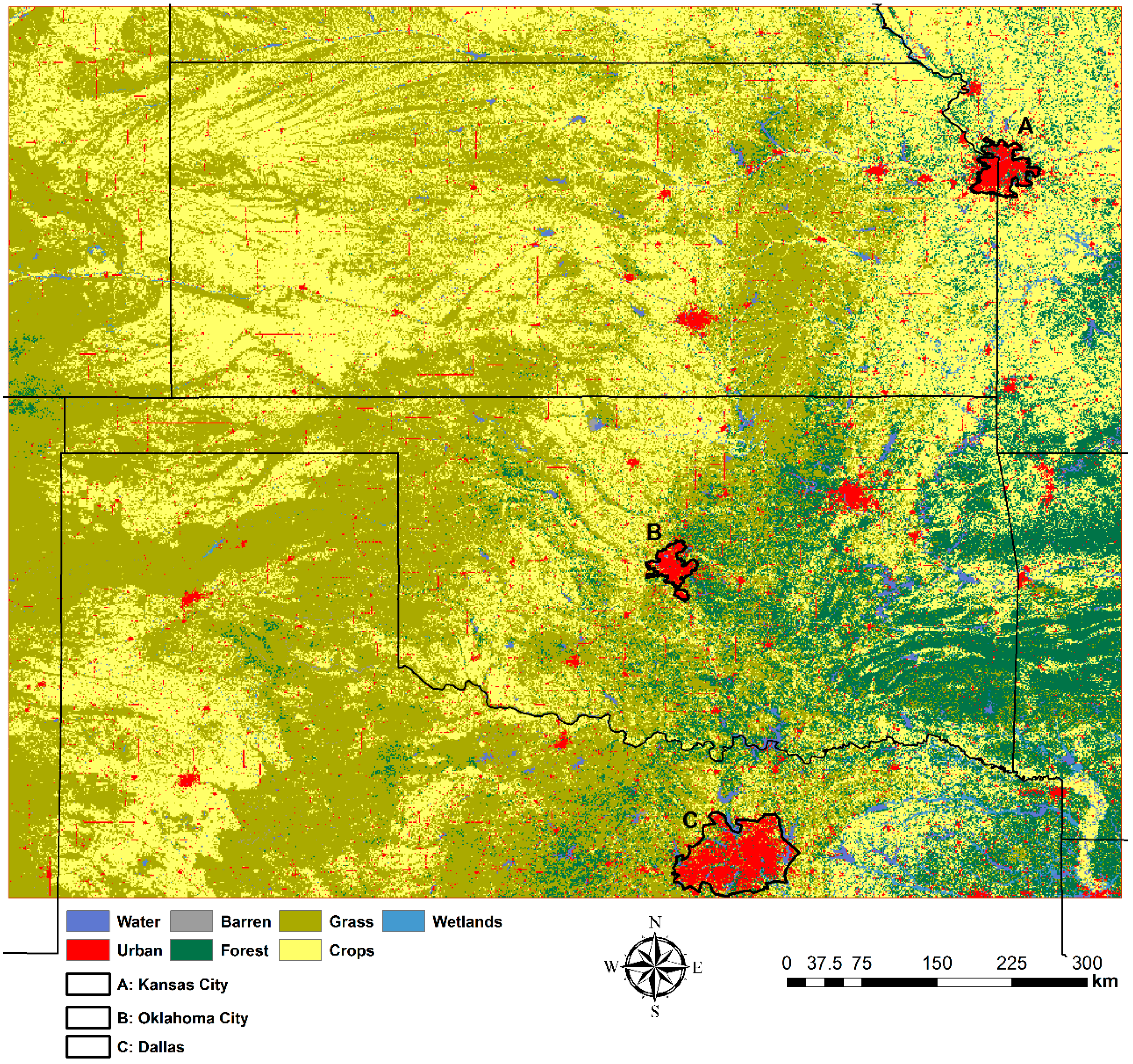

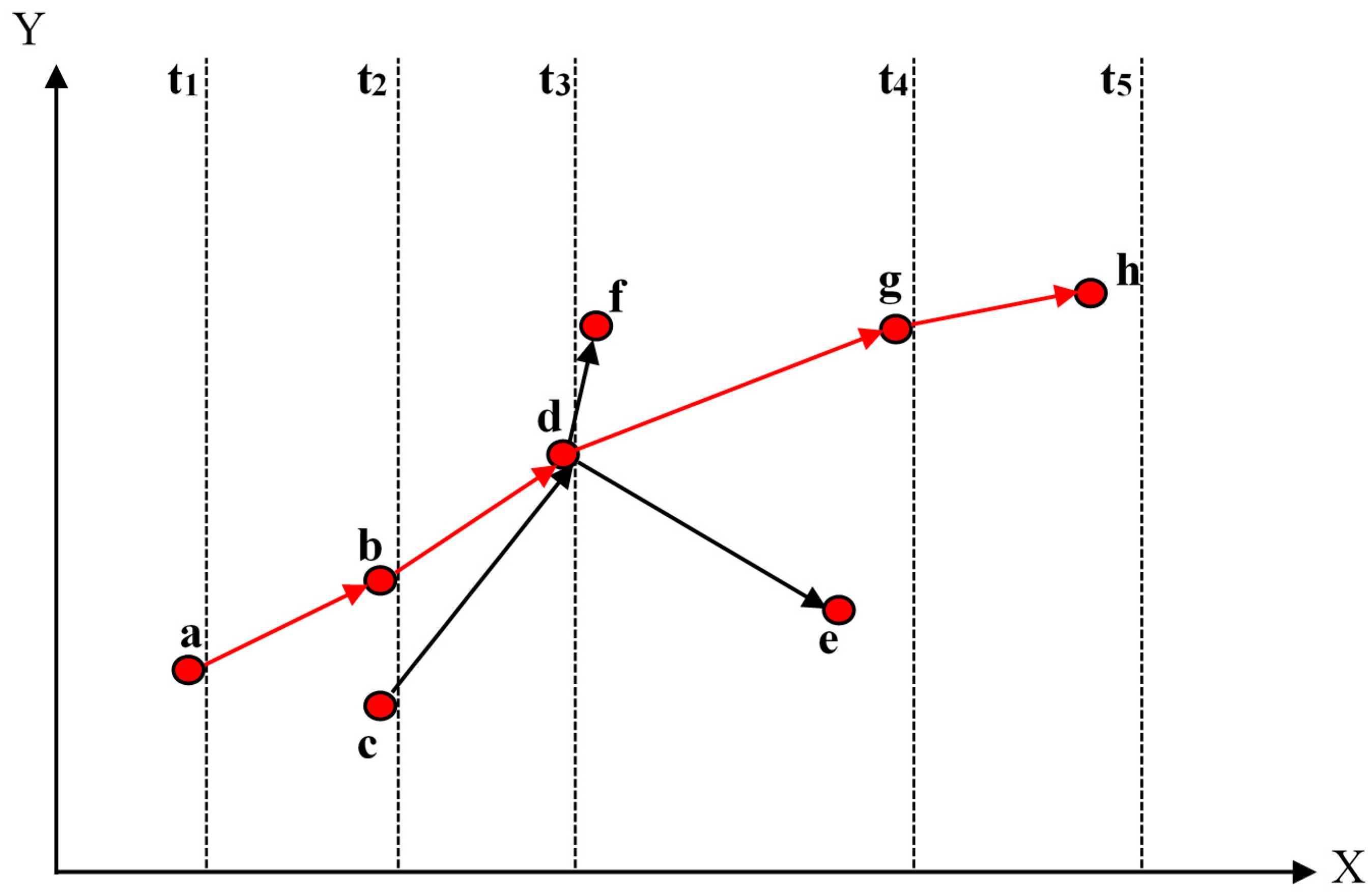
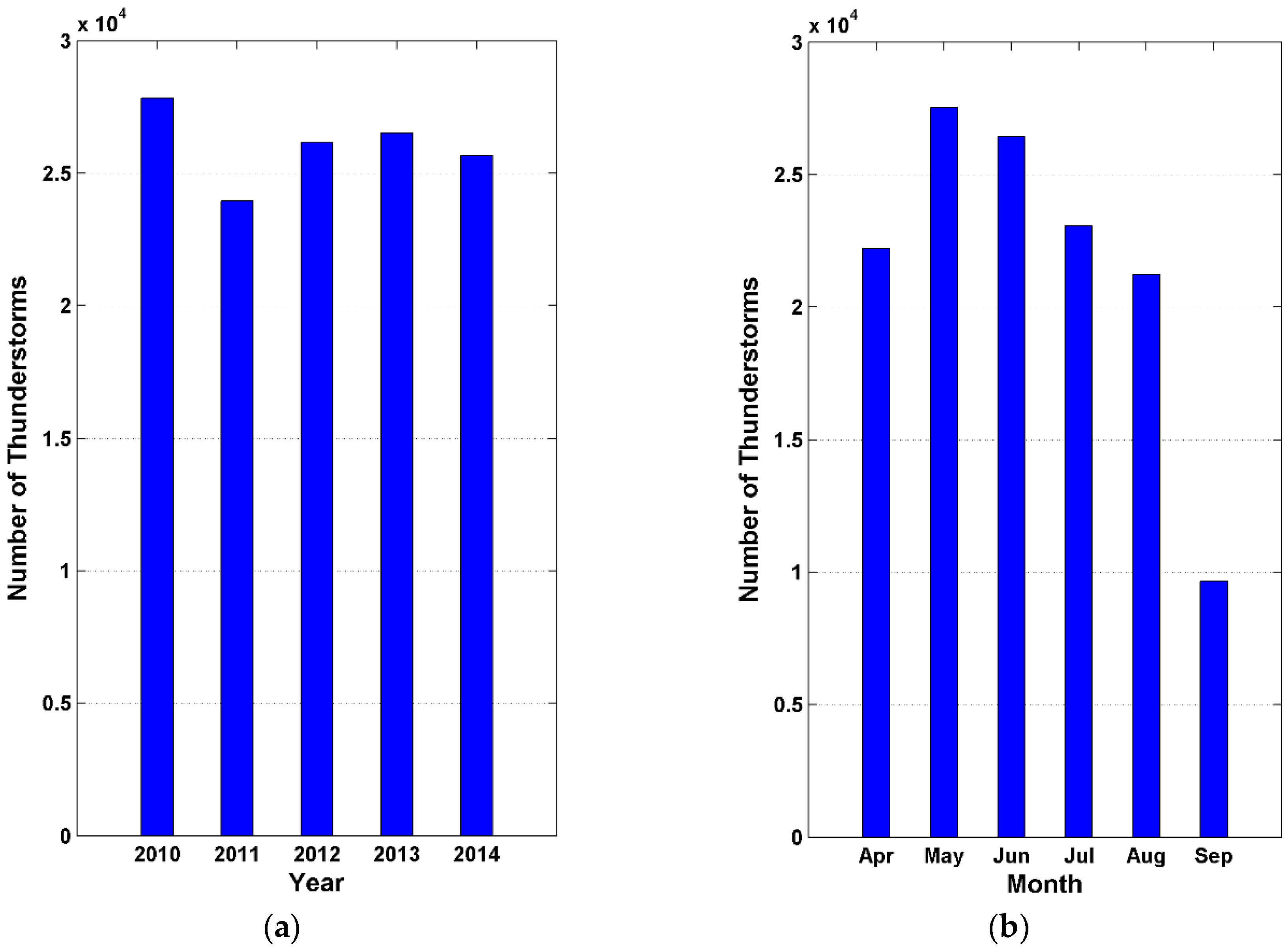
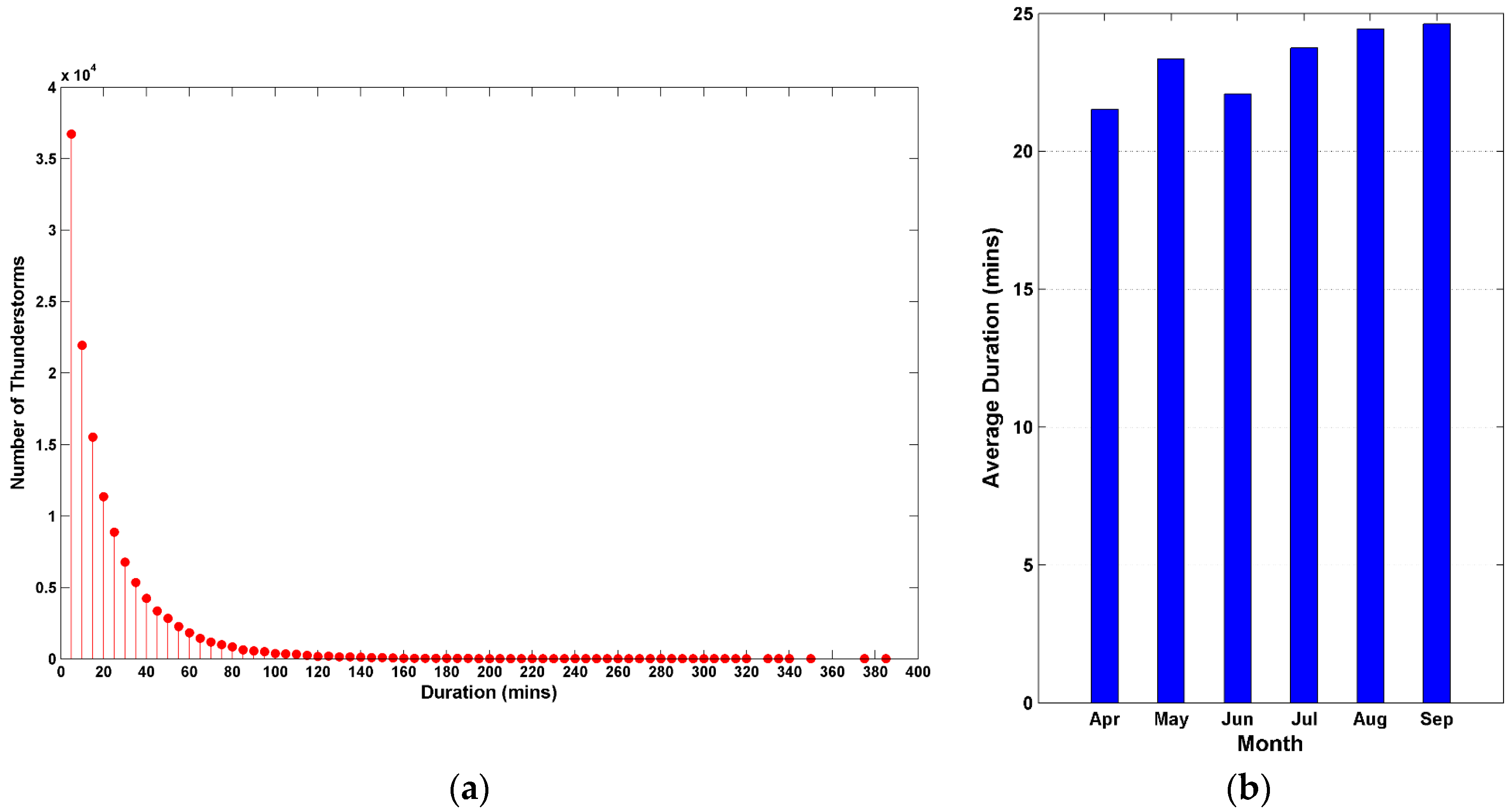
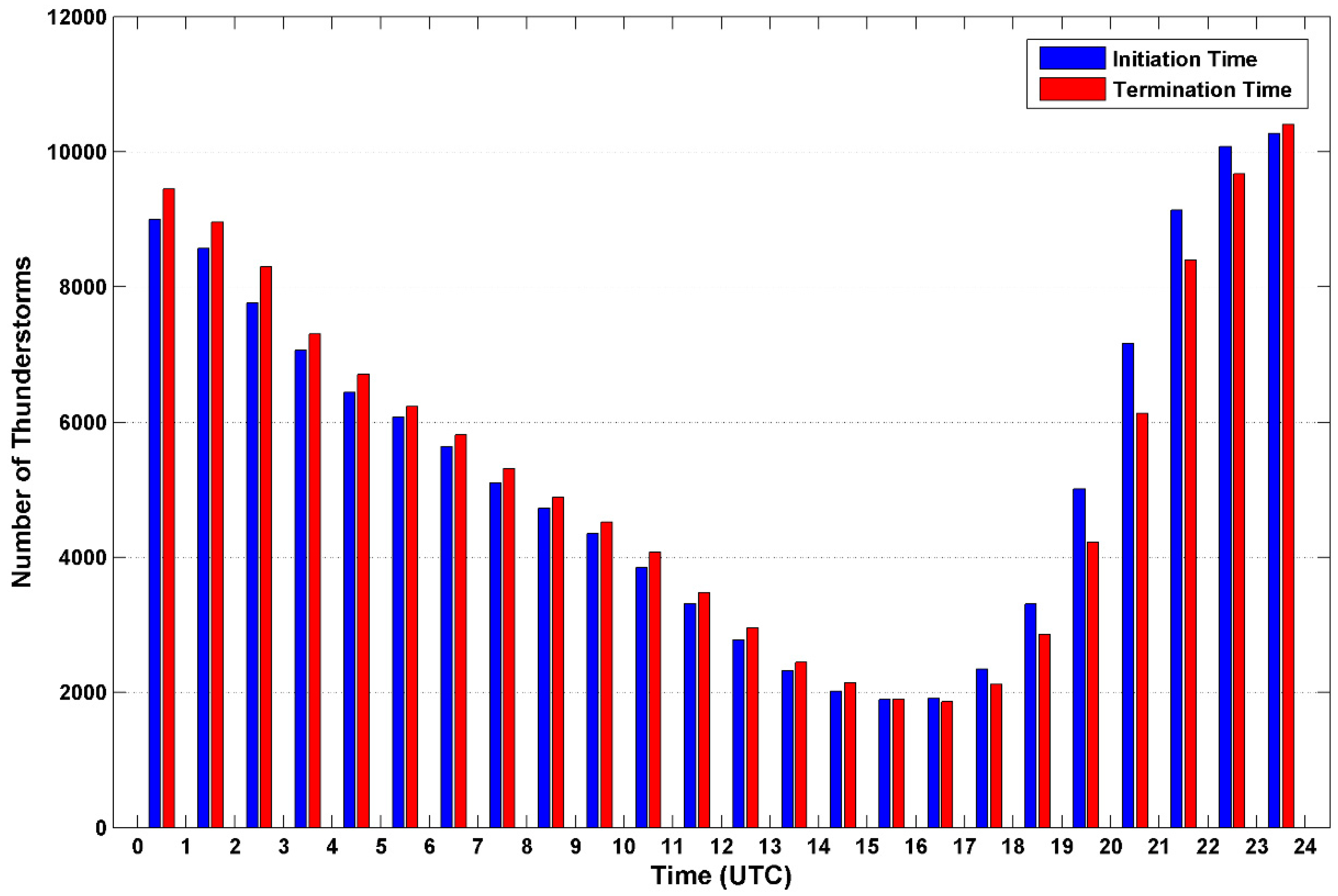
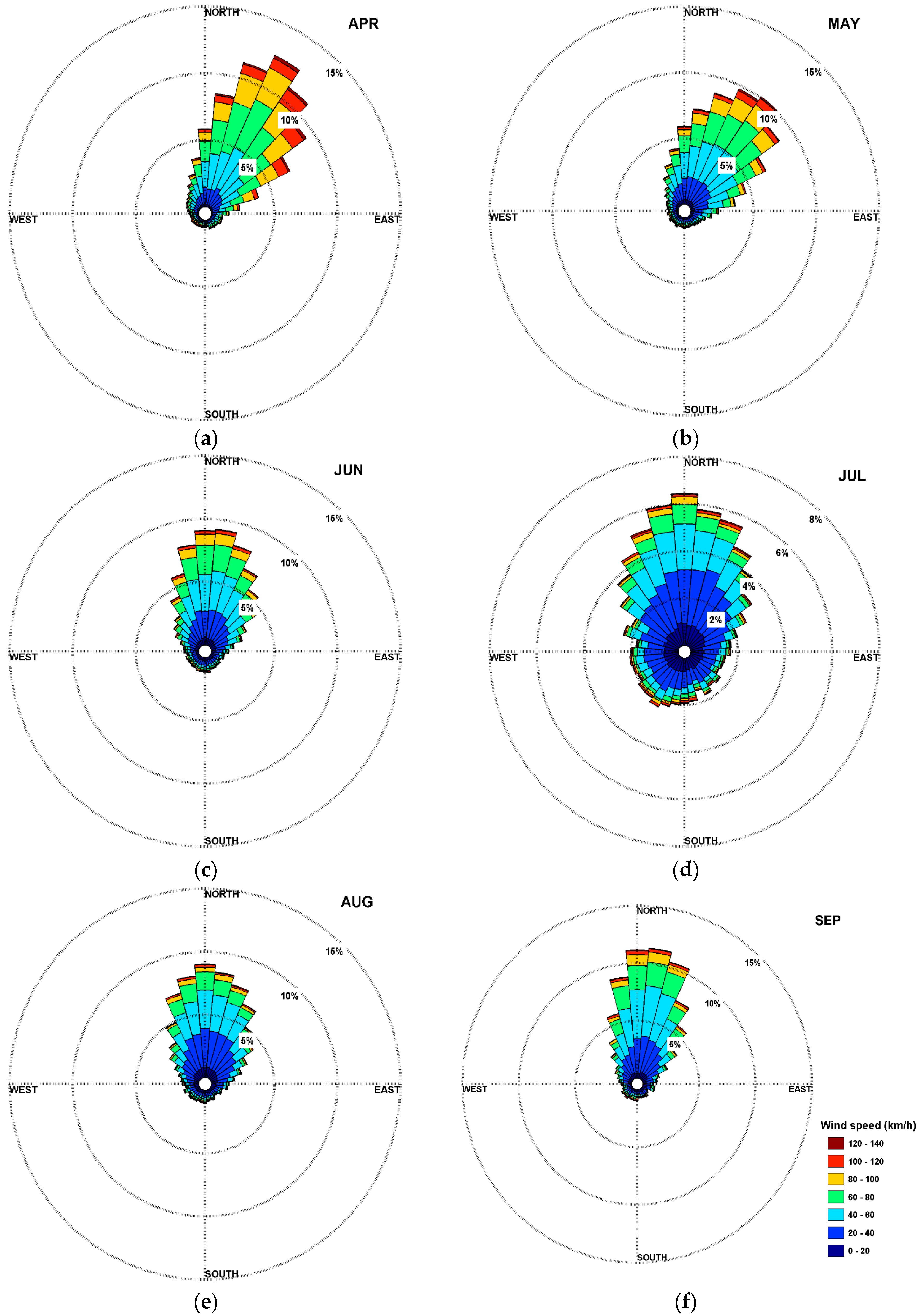
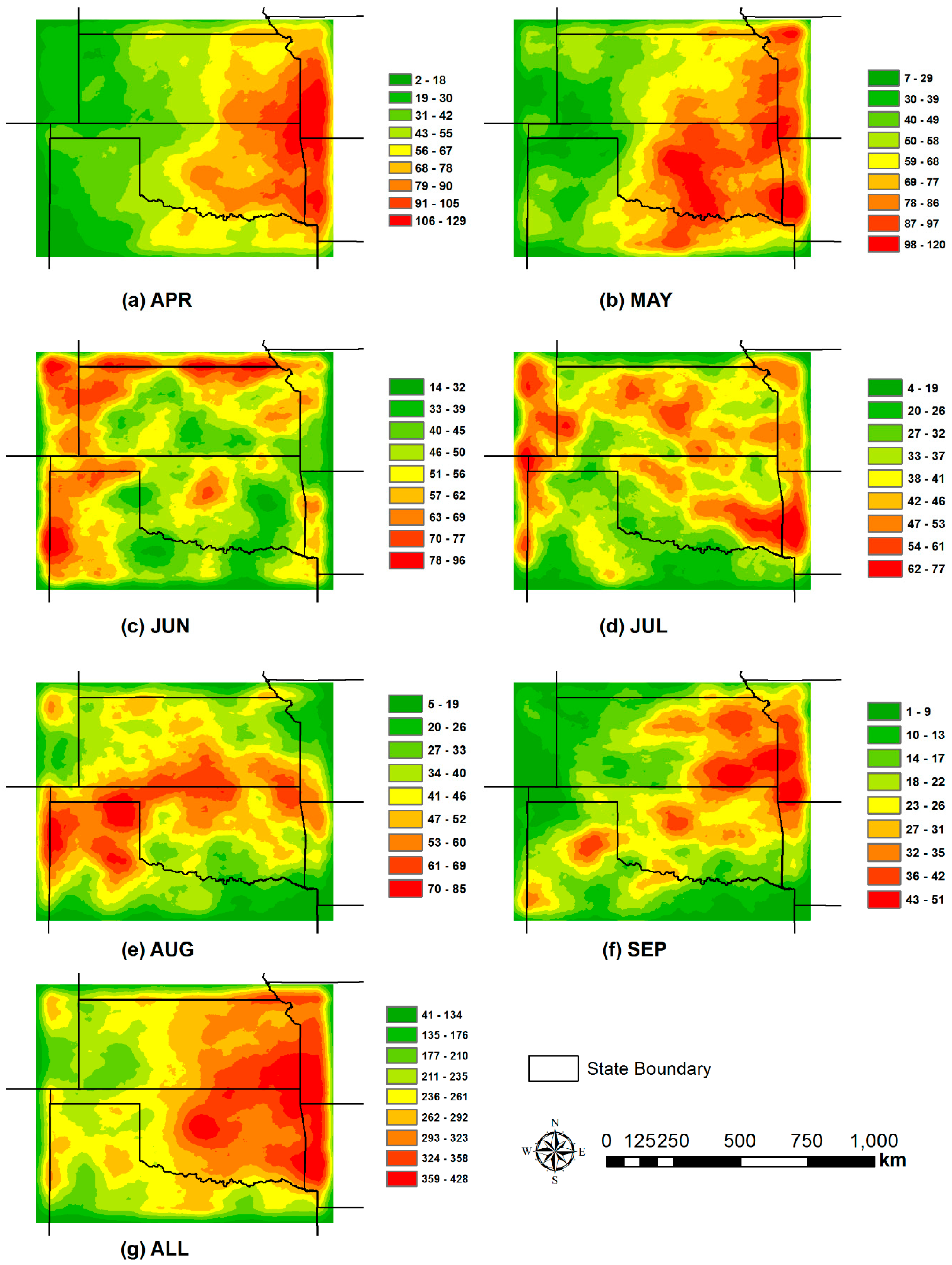
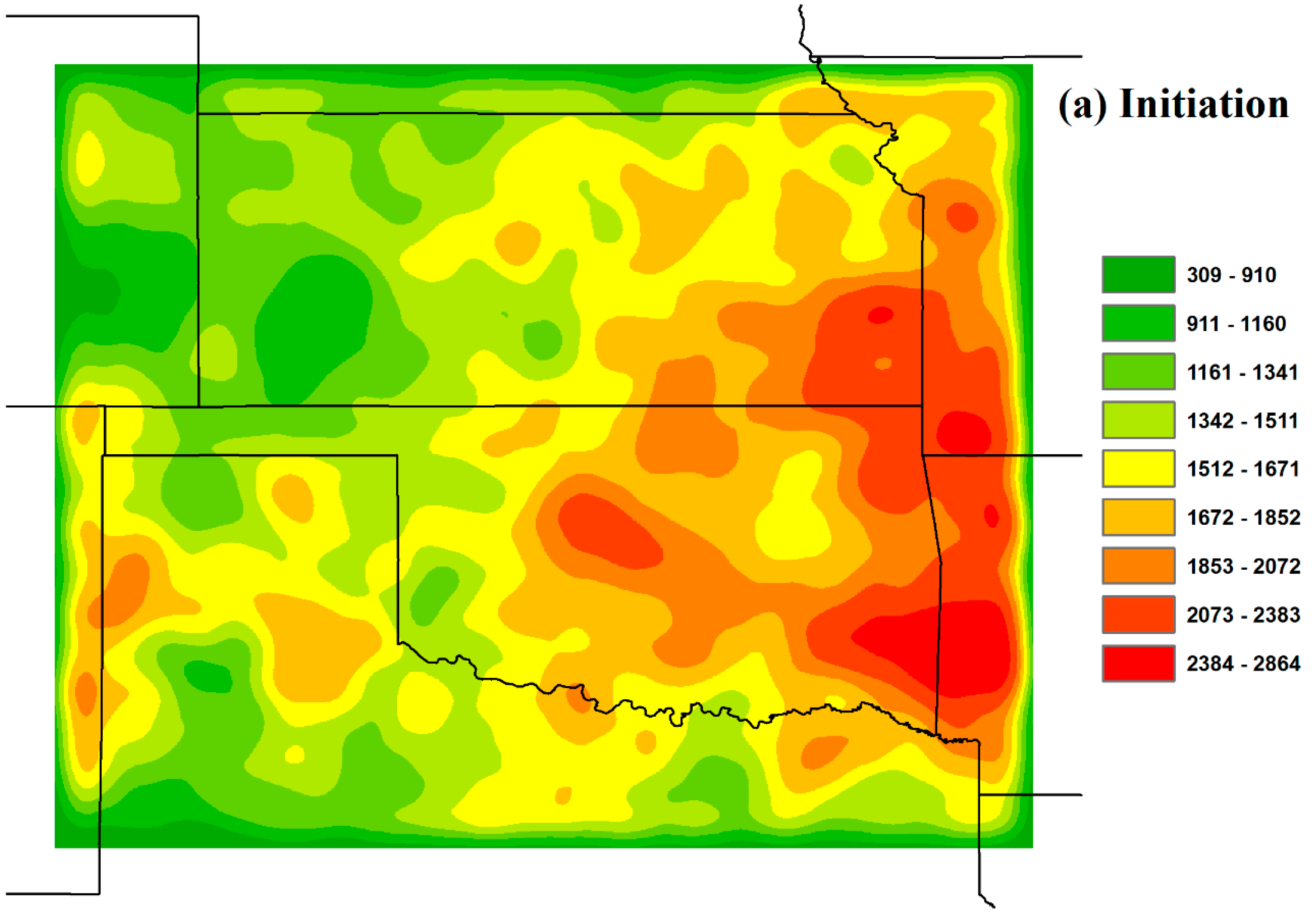
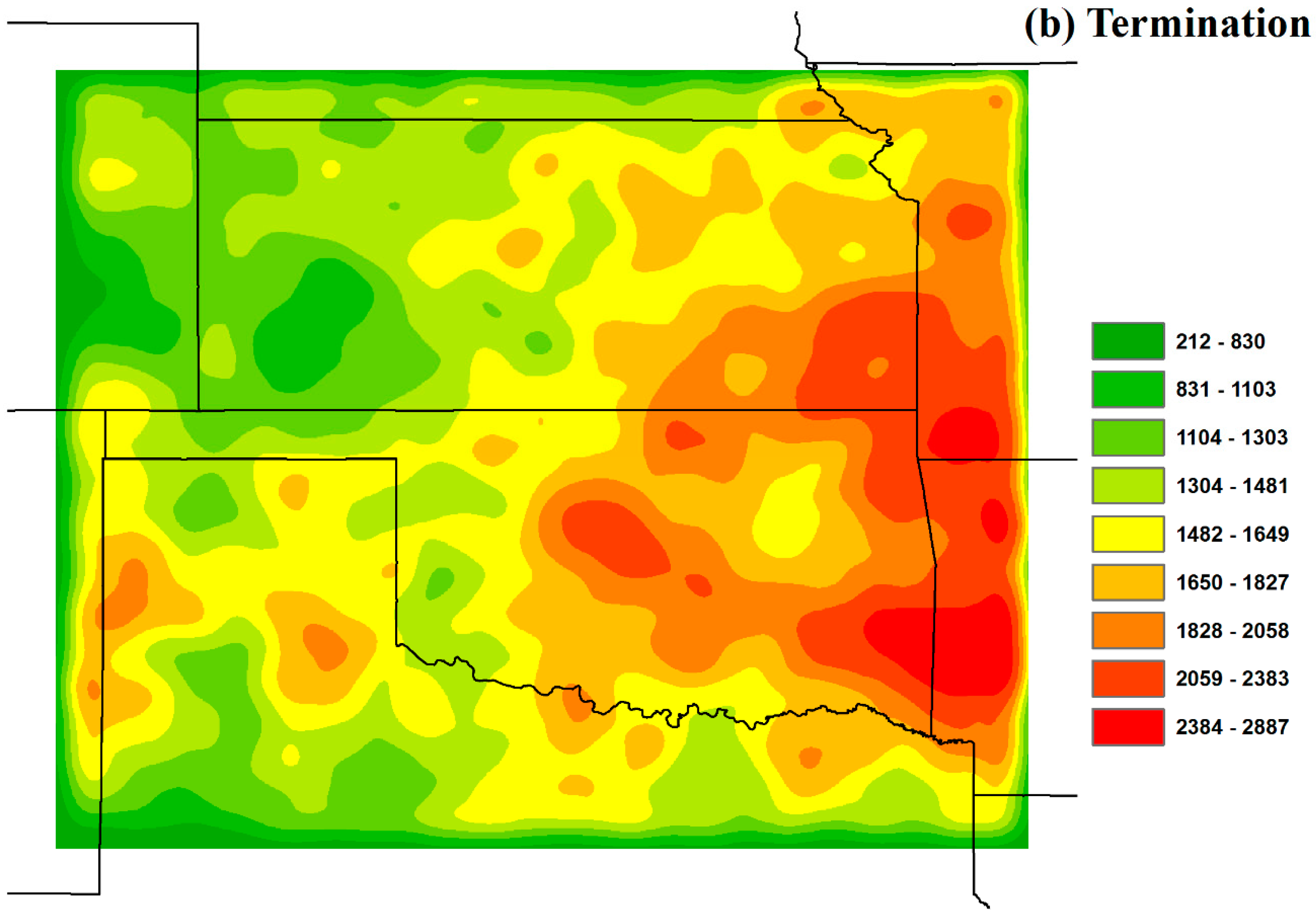
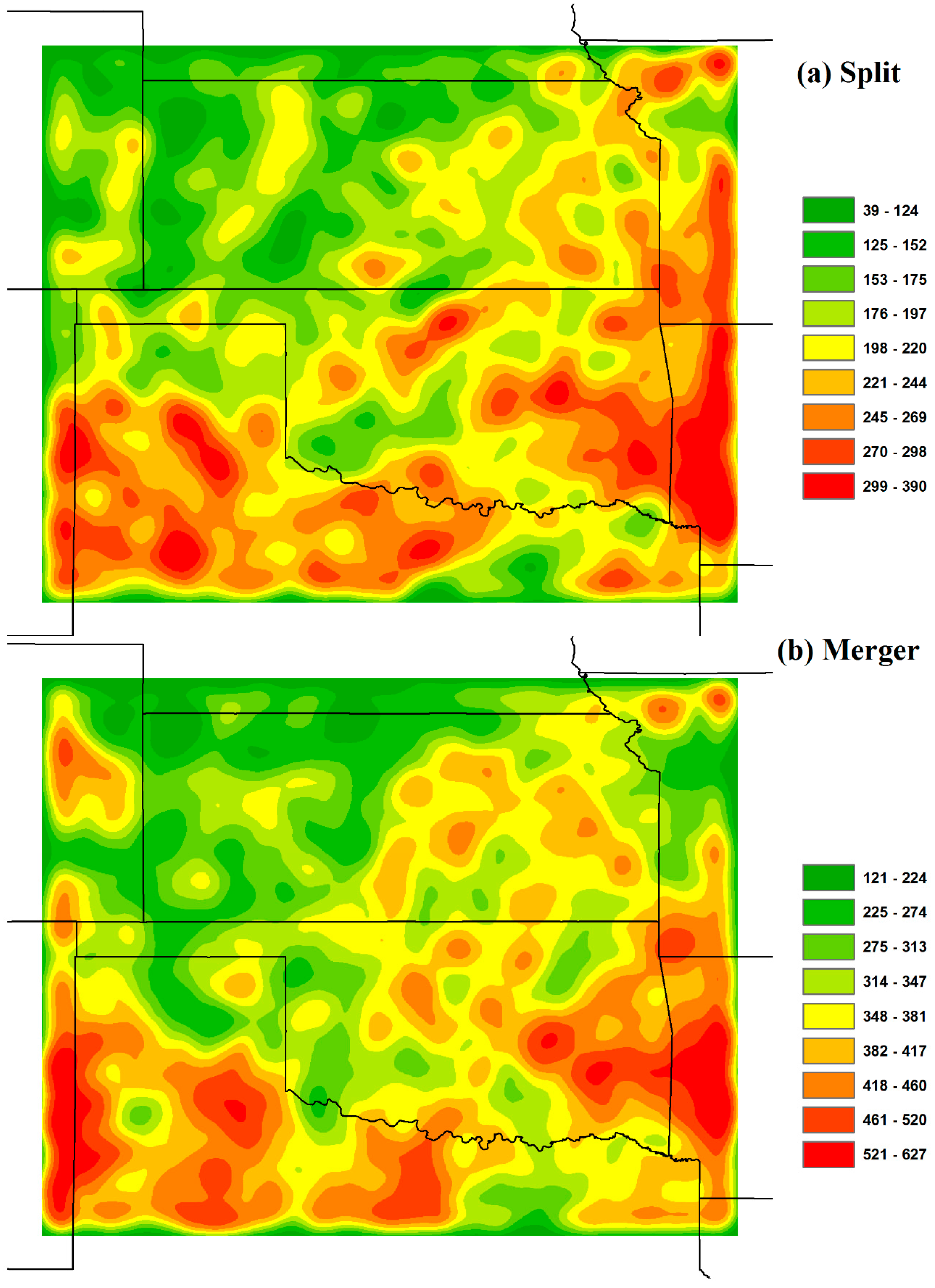
| Land Cover | Track | Initiation | Termination | Split | Merger |
|---|---|---|---|---|---|
| Forests | 303 | 1867 | 1904 | 242 | 404 |
| Urban | 282 | 1679 | 1689 | 208 | 350 |
| Crops | 271 | 1634 | 1629 | 228 | 390 |
| Water | 266 | 1624 | 1622 | 215 | 358 |
| Barren | 264 | 1603 | 1610 | 201 | 342 |
| Wetlands | 259 | 1549 | 1553 | 202 | 356 |
| Grass | 250 | 1504 | 1478 | 220 | 368 |
| Track t | Track p | Initiation t | Initiation p | |
|---|---|---|---|---|
| Kansas City | 11.79 | 0.000 | 26.47 | 0.000 |
| Oklahoma City | 17.21 | 0.000 | 32.51 | 0.000 |
| Dallas | −6.5 | 1.000 | −0.51 | 0.547 |
© 2016 by the authors; licensee MDPI, Basel, Switzerland. This article is an open access article distributed under the terms and conditions of the Creative Commons Attribution (CC-BY) license (http://creativecommons.org/licenses/by/4.0/).
Share and Cite
Liu, W.; Li, X. Life Cycle Characteristics of Warm-Season Severe Thunderstorms in Central United States from 2010 to 2014. Climate 2016, 4, 45. https://doi.org/10.3390/cli4030045
Liu W, Li X. Life Cycle Characteristics of Warm-Season Severe Thunderstorms in Central United States from 2010 to 2014. Climate. 2016; 4(3):45. https://doi.org/10.3390/cli4030045
Chicago/Turabian StyleLiu, Weibo, and Xingong Li. 2016. "Life Cycle Characteristics of Warm-Season Severe Thunderstorms in Central United States from 2010 to 2014" Climate 4, no. 3: 45. https://doi.org/10.3390/cli4030045
APA StyleLiu, W., & Li, X. (2016). Life Cycle Characteristics of Warm-Season Severe Thunderstorms in Central United States from 2010 to 2014. Climate, 4(3), 45. https://doi.org/10.3390/cli4030045






